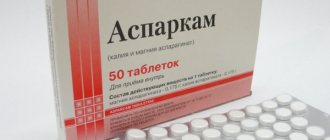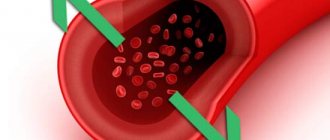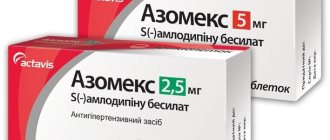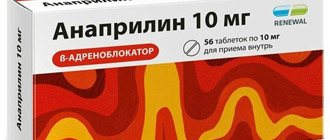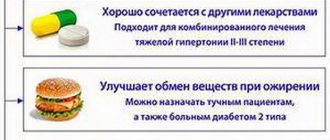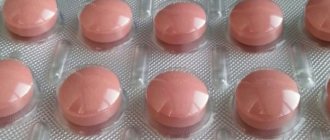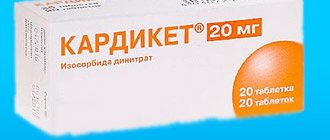0
Author of the article: Marina Dmitrievna
2017.11.28
587
Drugs
Many people, especially those who have reached old age, suffer the most from improper functioning of the cardiovascular system. As a rule, this unpleasant condition provokes the development of many serious diseases. To minimize the risk of developing such a situation, many specialists prescribe the drug Tonorma.
Tonorma
Pharmacodynamics and pharmacokinetics
A drug with a combined composition. The main effect is antihypertensive. The mechanism of action is due to the pharmacological properties of its components.
Atenolol is a β-adrenergic receptor and has antihypertensive and antianginal effects. Atenolol reduces heart rate , both during exercise and at rest, automatism of the sinus node, excitability and contractility of the myocardium, and reduces the need of the heart muscle for oxygen. slows down AV conduction .
Nifedipine - belongs to the dihydropyridine , a calcium channel blocker. Inhibits the process of calcium ions entering the cell, mainly into vascular smooth muscle cells. It has a pronounced antihypertensive effect, dilates the coronary vessels, which reduces the afterload on the heart and its need for oxygen, and improves blood supply to the myocardium. When combined with nifedipine, the antihypertensive effect is enhanced.
Chlorthalidone is a benzothiadiazine , a highly active diuretic. Blocks the reabsorption of sodium in the convoluted tubules of the kidneys, while chloride and sodium ions are excreted from the body in equivalent quantities.
It has a weakly expressed kaliuretic effect.
Pharmacokinetics
Atenolol is absorbed in the gastrointestinal tract at a level of 50–60%. Communication with blood proteins is low. Does not penetrate the blood-brain barrier , but easily overcomes the placental barrier and enters breast milk. T½ about 7 o'clock. The pharmacological effect lasts about one day. It is excreted unchanged through the kidneys.
Nifedipine is rapidly absorbed when taken orally. T½ 3 hours. Cmax in the blood after administration is reached within 40 minutes. It is excreted primarily in urine in the form of inactive metabolites.
Chlorthalidone - when taken orally, it is well absorbed from the gastrointestinal tract , absorbed on the surface of red blood cells, and the connection with blood proteins is low. The diuretic effect appears after 3 hours and lasts for 24 hours, sometimes more. Excreted through the kidneys and intestines.
Overdose of the drug Tonorma, symptoms and treatment
Symptoms : the clinical picture depends on the degree of intoxication and is manifested mainly by cardiovascular and central nervous system disorders. Overdose can lead to arterial hypotension, bradycardia, heart failure and cardiogenic shock. In severe cases, respiratory failure, bronchospasm, vomiting, and impaired consciousness are observed; extremely rarely - generalized convulsive attacks. Treatment: in case of overdose or with a threatening decrease in heart rate and/or blood pressure, treatment with Tonorma is stopped. In intensive care units, vital signs should be closely monitored and adjusted if necessary. If necessary, prescribe:
- atropine (0.5–2 mg IV bolus);
- glucagon: initial dose 1–10 mg IV (boost), subsequently 2–2.5 mg/hour as a continuous infusion;
- sympathomimetics depending on body weight and effect (dopamine, dobutamine, isoprenaline, oxyprenaline or adrenaline).
If drug treatment for bradycardia is not effective, cardiac pacing may be performed. For bronchospasm, β2-sympathomimetics are prescribed in the form of an aerosol (if the effect is insufficient, also IV) or aminophylline IV. For generalized convulsions, slow intravenous administration of diazepam is prescribed.
Side effects
General weakness, sleep disturbances, depression , hallucinations , confusion ; disturbances in concentration, paresthesia in the extremities, bradycardia , dry mouth, nausea, constipation, pancreatitis , hyperglycemia , thrombocytopenia , local allergic reactions, fatigue, photosensitivity, flushing , increased sweating.
Tonorma
Name: Tonorma Pharmacological action: Tonorma is a combined drug with an antihypertensive profile of action. It combines three first-line antihypertensive drugs: a cardioselective beta1-blocker - atenolol, a dihydropyridine vasodilator - nifedipine, a long-acting thiazide-like diuretic - chlorthalidone. The components of the drug interact with each other as a synergistic composition.
Atenolol is the main active ingredient of the drug, which causes an antihypertensive effect. Atenolol disrupts impulse transmission at beta1-adrenergic receptors, which reduces the stimulating effect of the sympathetic part of the autonomic nervous system and catecholamines on the cardiovascular system. Due to its cardioselective action, it very rarely provokes bronchospasm and is well tolerated when taken. Reduces heart rate during exercise and at rest, reducing contraction and excitation of the myocardium, reduces stroke and cardiac output, while simultaneously slowing down atrioventricular conduction. The antianginal effect is associated with a decrease in myocardial oxygen demand in the presence of atenolol.
Nifedipine belongs to the group of dihydropyridine calcium antagonists. By reducing the flow of calcium into vascular smooth muscle cells, it causes dilation of peripheral vessels and coronary arteries, reduces afterload on the heart muscle, improves blood circulation and blood supply in the myocardium, reducing the need for oxygen, which has not only an antihypertensive effect, but also an antianginal effect of the drug. Nifedipine reduces the degree of bradycardia that occurs during atenolol. Chlorthalidone is a highly active and long-acting monosulfamide diuretic, a benzothiadiazine derivative. The drug causes increased renal excretion of sodium and water, acting on the proximal part of the distal convoluted tubules of the kidney. As a result of the drug's action, the volume of circulating blood decreases and has a relaxing effect on the arterial vessels. Chlorthalidone does not cause significant changes in water-electrolyte balance and does not require additional correction of blood potassium, because has minimal potassium-sparing effect. Effectively used for insensitivity to hydrochlorothiazide.
The metabolism of each component of Tonorma occurs along different pathways. Atenolol - after oral administration in the gastrointestinal tract, its absorption reaches 60%. The T1/2 period ranges from 6 to 9 hours; in case of liver and kidney diseases, the half-life increases. The duration of pharmacological activity reaches an interval of up to 24 hours. The connection with blood proteins is quite low - no more than 5%. Eliminated from the body mainly with urine in the form of unchanged metabolites. Atenolol penetrates into breast milk and through the uteroplacental barrier. Little penetrates into the brain through the blood-brain barrier.
Nifedipine is actively absorbed through the gastrointestinal tract after oral administration. The pharmacological effect occurs after 30 minutes, when the highest concentration of the drug in the blood is reached. The T 1/2 period reaches an interval of up to 4 hours. Elimination of nifedipine occurs primarily in the urine and partially, up to 15%, in feces in an inactive form. Chlorthalidone has a long-lasting diuretic effect due to the fact that it is slowly eliminated by the kidneys. Rapidly absorbed after oral administration. The pharmacological effect occurs after 2-3 hours and lasts up to 24 hours, sometimes the residual effect of the drug is observed up to 72 hours. Period T 1/3 to 40 hours. In the bloodstream, it is absorbed on the surface of the erythrocyte and a small part of chlorthalidone binds to albumin. Eliminated mostly in feces and up to 25% in urine.
Indications for use: Arterial hypertension of various etiologies.
Directions for use: The drug is taken orally during or after meals, the tablet is swallowed whole, do not chew. Apply daily at the same time of day. Average therapeutic dose: one to two tablets once per 24 hours. The duration of the course of treatment and the choice of dose are determined individually by the attending physician.
Side effects: The drug is well tolerated. Side effects are quite rare and disappear after discontinuation of the drug. Minor undesirable effects do not require discontinuation of the drug. Changes in the central nervous system: sleep disturbances, depression, hallucinations, decreased concentration. Isolated cases include agitation, aggression, impaired consciousness. Changes in cardiovascular system: decreased heart rate, impaired atrioventricular conduction, feeling of coldness in the extremities. Changes in the gastrointestinal tract: stool disorders, nausea, dry mouth, liver dysfunction, very rarely - pancreatitis in females predominantly.
Changes in the endocrine system: with diabetes, a decrease or increase in blood glucose, impaired tolerance to carbohydrates. Changes in the blood system: decrease in the number of platelets, leukocytes, neutrophils, rarely - agranulocytosis, pancytopenia. Changes in the genitourinary system: erectile dysfunction, tubulointerstitial nephritis. Allergic manifestations: urticaria, skin itching, erythema. Changes in blood parameters: decreased levels of potassium, sodium, magnesium, increased cholesterol and triglycerides, increased uric acid and calcium levels.
Contraindications: - Myocardial infarction, acute process during the first eight days; - acute heart failure; - cardiogenic shock; — atrioventricular block of the 2nd and 3rd degree; — sick sinoatrial node syndrome; — sinus bradycardia with a heart rate less than 50 beats/min; - decrease in blood pressure with diabetes less than 90 mmHg; — severe chronic renal failure (GFR less than 30 ml/min), anuria; — severe form of liver dysfunction; - non-respiratory (metabolic) acidosis; - bronchial asthma; — late stage peripheral circulatory disorders; - taking MAO inhibitors (exception - MAO-B inhibitors); - individual intolerance to the drug or its components.
Pregnancy: Tonorma is not used during pregnancy and in women who are breastfeeding.
Interaction with other drugs: Anesthesia increases the pharmacological activity of the drug Tonorma. The drug component, atenolol, reduces the pharmacological activity of sympathomimetics and enhances the effect of indirect anticoagulants. Do not combine Tonorm with MAO inhibitors. Digitalis and Tonorma preparations have a mutually synergistic effect, which enhances atrioventricular block. NSAIDs reduce the pharmacological effects of Tonorma. Do not use simultaneously with rifampicin, because against this background, the bioavailability of nifedipine sharply decreases.
Ranitidine and cimetidine increase nifedipine levels. Grapefruit juice suppresses the metabolism of nifedipine in the body, and as a result increases the half-life, increasing the decrease in blood pressure. Tonorma enhances the effect and increases the activity of insulin and hypoglycemic agents, which leads to impaired control of diabetes mellitus. The use of ethanol, diuretics, nitarts, phenothiazines, barbiturates, blood pressure lowering agents, tricyclic antidepressants and peripheral vasodilators in combination with Tonorma increases the antihypertensive effect of the latter.
Overdose: The main manifestations of overdose are disorders of the cardiovascular system and central nervous system. The degree and severity of manifestations depends on the level of the drug taken and toxic effects. An overdose is accompanied by a sharp decrease in blood pressure and heart rate, heart failure, which can lead to cardiogenic shock. Severe overdose – impaired consciousness and breathing, spasm of the bronchial tract, vomiting, manifestations of generalized convulsions.
Medical care: in case of blood pressure disorders or severe bradycardia, Tonorma should be discontinued.
Symptomatic treatment, if necessary, use the following medications: - bolus therapy with atropine - infusionally administered from 0.5 to 2 mg at a time; — to relieve hypoglycemia, glucagon is administered: initially in a bolus from 1 to 10 mg, then switched to a long-term infusion of 2-2.5 mg/h; - drugs with sympathomimetic action - dobutamine, dopamine, isoprenaline, oxyprenaline, adrenaline; — in the absence of effectiveness and a progressive decrease in heart rate, electrical cardiac stimulation is used; — to relieve bronchospasm, β2-sympathomimetics are used by aerosol, in severe cases by infusion. Aminophylline infusion may be used; - for convulsive manifestations, diazepam is administered intravenously. During intensive therapy, the body's vital signs are carefully monitored.
Release form: Tablets p/o No. 10. Cardboard packaging No. 10, No. 30.
Storage conditions: Temperature no more than 25 degrees Celsius, store in a dark place.
Composition: Atenolol - 0.1 g; Chlorthalidone - 0.025 g; Nifedepine 0.01 g.
Excipients: Mg carbonate basic, potato starch, Aerosil A 300, talk, Mg stearate, Na lauryl sulfate, Hypromellose Methocel E50 LV Premium, Hypromellose Methocel E5 Premium LV, polyethylene glycol (or Macrogol 1500), titanium dioxide, dye (Sunset yellow EEC110 ) or sepifilm 752 white.
Additionally: In persons with carbohydrate metabolism disorders and diabetes mellitus, Tonorma is prescribed with caution due to possible changes in blood glucose levels, which impairs the ability to effectively control the course of the disease. Use the drug with caution in case of conduction disorders in the heart muscle, gout, diseases that are accompanied by an obliterating process of peripheral vessels, Raynaud's disease, severe dysfunction of the liver and kidneys, psoriasis, depression, the elderly, and disturbances in water-electrolyte balance in the body. It is impossible to abruptly cancel Tonorma due to the fact that it is possible to develop an attack of angina pectoris, up to the development of myocardial infarction in isolated cases.
During surgical interventions, the drug is gradually withdrawn until there is no drug intake for 48 hours by the time of the operation using anesthesia. When treating with Tonorma, the use of alcohol is contraindicated. Toneorma is not prescribed for children under 16 years of age. Due to the fact that the drug can affect the function of the central nervous system, it is not recommended to drive vehicles or work with complex mechanisms during treatment with Tonorma.
Attention! The description of the drug " Tonorma " on this page is a simplified and expanded version of the official instructions for use. Before purchasing or using the drug, you should consult your doctor and read the instructions approved by the manufacturer. Information about the drug is provided for informational purposes only and should not be used as a guide to self-medication. Only a doctor can decide to prescribe the drug, as well as determine the dose and methods of its use.
Interaction
When Tonorma is taken together with antidiabetic drugs and insulin , their sugar-lowering effect is enhanced. With the simultaneous use of the drug with antihypertensive drugs of different groups, the hypotensive effect of such drugs is enhanced. The effect of atenolol is enhanced when taken together with anesthesia. When prescribing Tonorma with clonidine , reserpine , verapamil or methyldopa, there is a risk of developing severe bradycardia .
When taking the drug together with alcohol or psychotropic drugs (tranquilizers, sleeping pills, antipsychotics, antidepressants), the hypotensive effect may be enhanced. Atenolol may potentiate the effect of indirect anticoagulants and reduce the bronchodilator effectiveness of sympathomimetics. It is not recommended to prescribe Tonorm together with MAO inhibitors . The simultaneous use of Tonorma with grapefruit juice increases the concentration of nifedipine and, due to a decrease in its metabolism, increases the hypotensive effect.
Contraindications to the use of the drug Tonorma
- the first 8 days after myocardial infarction;
- acute heart failure;
- cardiogenic shock;
- AV block II and III degrees;
- severe renal dysfunction, anuria, severe liver dysfunction;
- sick sinus syndrome;
- sinoatrial block;
- sinus bradycardia; (heart rate less than 50 beats/min);
- arterial hypotension (systolic pressure less than 90 mm Hg);
- BA;
- metabolic acidosis;
- late stages of peripheral circulatory disorders;
- simultaneous use of MAO inhibitors (with the exception of MAO-B inhibitors);
- hypersensitivity to other components of the drug;
- severe renal dysfunction, anuria.
Reviews about Tonorm
Reviews of Tonorma among patients taking the drug are mostly positive.
“... I have suffered from hypertension for more than 20 years. She was treated with many medications. Three months ago, the doctor suggested trying the drug Tonorma. After the course of treatment, the pressure became more or less stable, there were no sudden changes, my head became clearer and there were no severe headaches.”
According to doctors, Tonorma is a fairly effective antihypertensive drug. Its use provides a significant reduction in blood pressure , a decrease in LV and an improvement in intracardiac hemodynamics. The drug is well tolerated by patients, there are no negative changes in the biochemical parameters of urine and blood.
Special instructions for the use of the drug Tonorma
The drug should be prescribed with caution to patients with diabetes mellitus ((control of blood glucose levels), patients with AV block of the first degree, patients with gout, with impaired liver function, kidney function, Raynaud's disease, patients with obliterating diseases of the peripheral arteries. The drug should be prescribed with caution to patients with psoriasis, depression, elderly patients, with water-electrolyte imbalance. Treatment with Tonorma should not be stopped abruptly, as it can cause increased attacks of angina, in some cases myocardial infarction may develop (withdrawal syndrome). The drug should be stopped 48 hours before surgery intervention, which is planned to be carried out using general anesthesia. During treatment, it is necessary to stop drinking alcohol. Use during pregnancy and lactation. The use of the drug Tonorma is contraindicated during pregnancy and lactation. Children . The drug is not prescribed to children under 16 years of age. Ability influence the speed of reactions when driving vehicles or working with other complex mechanisms. During treatment, it is not recommended to drive vehicles or operate other complex machinery.
Tonorma price, where to buy
The price of Tonorm tablets No. 10 varies between 185 - 220 rubles per pack: No. 30 - 550-600 rubles. In most pharmacies in Moscow, you can buy Tonorm only by pre-order or purchase its structural analogues.
- Online pharmacies in RussiaRussia
- Online pharmacies in UkraineUkraine
LuxPharma* special offer
- Tonic tab.
N30 1400 rub. order
show more
Pharmacy24
- Tonorma No. 10 tablets PrAT" Pharmaceutical company "Darnitsa", Ukraine
37 UAH. order - Tonorma No. 30 tablets PrAT” Pharmaceutical company “Darnitsa”, Ukraine
106 UAH order
Mode of application
Tonorma is taken orally. The tablet is absorbed entirely, does not bite or dissolve, and is washed down with plenty of clean water. The dosage of the drug and the duration of treatment are prescribed by the doctor. The patient feels relief a few hours after taking Tonorma. The effect of the medication lasts about a day.
Important! Take the drug at one time.
Oral method of administration
Analogues of Tonorma
If the patient cannot treat hypertension with Tonorma, a specialist can prescribe an analogue. According to patient reviews, the most effective include:
- Beta Azomex.
- Amlodak-At.
- Logimax.
- Stamlo-Met.
- Alotendin, instructions for use.
- Neocard-Atn.
- Amlong-A.
In Russian pharmacies, these drugs can be purchased at a favorable price only with a prescription. At the moment, there is no effective Russian analogue of Tonorma, so experts recommend buying the original one or using foreign analogues.
Overdose
If a patient drinks a large dose of Tonorma, the functionality of the central nervous system and cardiovascular system malfunctions, cardiogenic shock develops, and blood pressure and heart rate drop sharply.
The severity and negative impact of an overdose on the body depends on the number of tablets taken.
A severe overdose can cause breathing problems, vomiting and loss of consciousness. Convulsions and bronchial spasms rarely develop.
In case of Tonorma poisoning, the following measures should be taken:
- In case of bradycardia and blood pressure surges, immediately stop using the drug.
- For convulsive attacks - intravenous administration of Diazepam.
- Aminophylline infusions are used to prevent bronchospasm.
- Heart rate is restored by electrical pacing.
- To restore glucose concentration, use an injection or infusion of Glucagon.
- Some patients are prescribed the following drug combinations: Atropine/Oxyprenaline, Dopamine/Dobutamine, Adrenaline/Isoprenaline.
Side effects
Judging by the clinical data, patients taking Teraligen tablets tolerate the drug well. Therefore, the occurrence of side effects is rare. But if they do exist, then the list of side effects is as follows:
- From the genitourinary system: urinary retention, bladder atony.
- From the respiratory system: increased viscosity of bronchial secretions, dryness of the mucous membrane of the nose and pharynx.
- Allergic reactions: urticaria, photosensitivity, allergic dermatitis, Quincke's edema.
- Laboratory indicators: false positive pregnancy test result.
- From the senses: decreased visual acuity, ringing and tinnitus. From the blood vessels and heart: arterial hypotension, cardiac arrhythmia, dizziness.
- From the digestive tract: dry mouth, intestinal atony, anorexia, constipation.
- From the nervous system: asthenia, drowsiness, fatigue, paradoxical reactions (including anxiety, nightmares, irritability and agitation), confusion. In addition, it is possible to develop increased frequency of sleep apnea, increased seizure activity, as well as extrapyramidal disorders (including akathisia, hypokinesia and tremor).
- Others: increased sweating, decreased bone marrow function, muscle relaxation.
In addition, alimemazine can distort the results of skin prick tests for various allergens. Therefore, if you are having an allergy test, you should stop taking the drug no later than 72 hours in advance.
